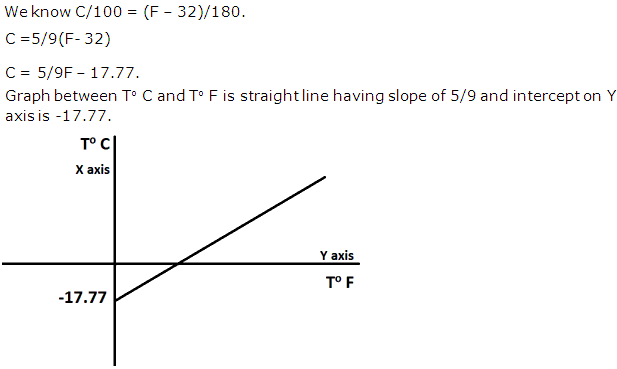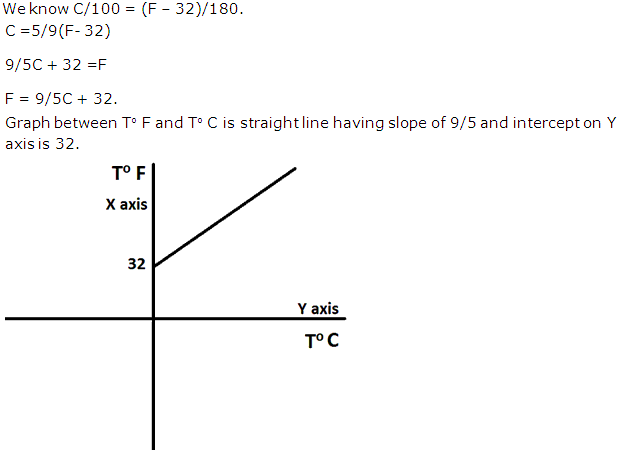Class 9 FRANK Solutions Physics Chapter 5 - Heat - Thermometry
Manage your last-minute revision of syllabus concepts easily with Frank Solutions for ICSE Class 9 Physics Chapter 5 Heat – Thermometry. Understand the principle used in the making of a thermometer. Also, find out why mercury is used in a thermometric liquid and not water.
You need a thorough understanding of concepts to score top marks in your ICSE Class 9 Physics exam. For conceptual clarity, TopperLearning helps you with reliable textbook solutions, video lessons and self-assessment resources. To resolve doubts related to Thermometry, ask questions through our ‘UnDoubt’ platform.
209
210
Heat - Thermometry Exercise 209
Solution 1
Temperature is the quantity that tells about the thermal state of a body i.e. the degree of hotness or coldness of a body.
Solution 2
Thermometer is used for measuring the temperature of a body.
Solution 3
Thermometer works on the principal that substances expand when heated and contract on cooling.
Solution 4
Range of thermometer is the range of temperature which can be measured by thermometer.
Solution 5
Mercury is the liquid used in a clinical thermometer
Solution 6
The usual range of temperature marked on clinical thermometer is 950 F to 1100F.
Solution 7
Fahrenheit designed the first thermometer.
Solution 8
Before constructing a thermometer, we determine lower fixed point and upper fixed point and divide the whole range of thermometer into specific number of equal divisions to provide a scale for measuring the temperatures within a range.
Solution 9
The clinical thermometer is specially designed thermometer used to measure the temperature of a human body easily and as accurately as possible.
Solution 10
Three properties of a liquid which make it suitable to be used in a thermometer are:
(i) The substance should have high coefficient of expansion so that it is sensitive to the smallest change in temperature
(ii) The substance should have uniform expansion all over its entire volume
(iii) The substance should have minimum specific heat so that it absorbs minimum heat from the body under measurement.
(i) The substance should have high coefficient of expansion so that it is sensitive to the smallest change in temperature
(ii) The substance should have uniform expansion all over its entire volume
(iii) The substance should have minimum specific heat so that it absorbs minimum heat from the body under measurement.
Solution 11
Two disadvantages of using mercury as a thermometric liquid:
(i) It does not have uniform expansion.
(ii) Mercury is less sensitive than alcohol as its coefficient of expansion is less than alcohol.
(i) It does not have uniform expansion.
(ii) Mercury is less sensitive than alcohol as its coefficient of expansion is less than alcohol.
Solution 12
Three advantages of using mercury as a thermometric liquid:
(i) Mercury is good conductors of heat.
(ii) Mercury have high coefficient of expansion thus is sensitive to the smallest change in temperature.
(iii) Freezing points is very low and boiling point is high.
(i) Mercury is good conductors of heat.
(ii) Mercury have high coefficient of expansion thus is sensitive to the smallest change in temperature.
(iii) Freezing points is very low and boiling point is high.
Solution 13
Water is not used as a thermometric liquid because it has low coefficient of expansion so it is less sensitive to temperature changes. Moreover, it is transparent thus making it difficult to read the thermometer and water evaporates with time thus producing error and also the freezing and boiling points are also low.
Solution 14
Temperature in Kelvin To K = Temperature in Celsius To C + 273.
To K = 0oC + 273
To K =273 K.
To K = 0oC + 273
To K =273 K.
Solution 15
Body temperature of a healthy person is 98.4oF.
We know C/100 = (F - 32)/180.
C =5/9(F- 32)
C = 5/9(98.4 - 32)
C = 5/9 X66.4
C =36.88oC
Temperature of body of healthy man is 36.88oC.
We know C/100 = (F - 32)/180.
C =5/9(F- 32)
C = 5/9(98.4 - 32)
C = 5/9 X66.4
C =36.88oC
Temperature of body of healthy man is 36.88oC.
Solution 16
Absolute scale of temperature is Kelvin scale.
Conversion of temperature from Celsius to Kelvin scale is
Temperature in Kelvin To K = Temperature in Celsius To C + 273.
So a rise of temperature of 1oC in Celsius scale is equal to rise of 1oK in Kelvin scale.
Conversion of temperature from Celsius to Kelvin scale is
Temperature in Kelvin To K = Temperature in Celsius To C + 273.
So a rise of temperature of 1oC in Celsius scale is equal to rise of 1oK in Kelvin scale.
Solution 17
Kelvin temperature scale is used in SI system.
Solution 18
In Celsius scale there are two fixed points namely lower fixed point and upper fixed point at 0oC and 100oC respectively. This range is divided into 100 equal divisions and each part gives 1oC.
Solution 19
We know C/100 = (F - 32)/180.
C =5/9(F- 32)
9/5C + 32 =F
F = 9/5C + 32.
Temperature given in Celsius = -15oC.
F = 9/5 X (-15) +32
F = -27 +32
F = 5oF.
C =5/9(F- 32)
9/5C + 32 =F
F = 9/5C + 32.
Temperature given in Celsius = -15oC.
F = 9/5 X (-15) +32
F = -27 +32
F = 5oF.
Solution 20
Absolute zero of temperature is 0oK.
Temperature in Kelvin To K = Temperature in Celsius To C + 273.
0oK = To C +273.
To C = -273oC.
Absolute zero of temperature on Celsius scale is -273oC.
Temperature in Kelvin To K = Temperature in Celsius To C + 273.
0oK = To C +273.
To C = -273oC.
Absolute zero of temperature on Celsius scale is -273oC.
Solution 21
Difference of temperature of two bodies in Celsius scale = 1oC.
We know C/100 = (F - 32)/180.
C =5/9(F- 32)
9/5C + 32 =F
F = 9/5C + 32.
So, difference of 1o in Celsius scale is equal to the difference of 9/5o in Fahrenheit scale.
Thus, Difference of 1oC of temperature of two bodies in Celsius scale is equal to difference of 1.8o in Fahrenheit scale.
We know C/100 = (F - 32)/180.
C =5/9(F- 32)
9/5C + 32 =F
F = 9/5C + 32.
So, difference of 1o in Celsius scale is equal to the difference of 9/5o in Fahrenheit scale.
Thus, Difference of 1oC of temperature of two bodies in Celsius scale is equal to difference of 1.8o in Fahrenheit scale.
Solution 22
Celsius invented the Celsius scale of temperature.
Solution 23
Fahrenheit invented the Fahrenheit scale of temperature.
Solution 24
Mercury, alcohol are commonly used in thermometers.
Heat - Thermometry Exercise 210
Solution 25
Camel and are two animals which are able to increase their body temperature in summers and decrease their body temperature in winters.
Solution 26
CGS unit of heat is Joule denoted by J.
1 J is amount of heat required to raise the temperature of a body by 1/4.12oC of temperature.
1 J is amount of heat required to raise the temperature of a body by 1/4.12oC of temperature.
Solution 27

Solution 28

Solution 29
Relation between Celsius and Fahrenheit scales of temperature is
C/100 = (F - 32)/180.
C/100 = (F - 32)/180.
Solution 30
Temperature of ice point on Fahrenheit scale =32oF.
Temperature of steam point on Fahrenheit scale =212o
Temperature of steam point on Fahrenheit scale =212o

